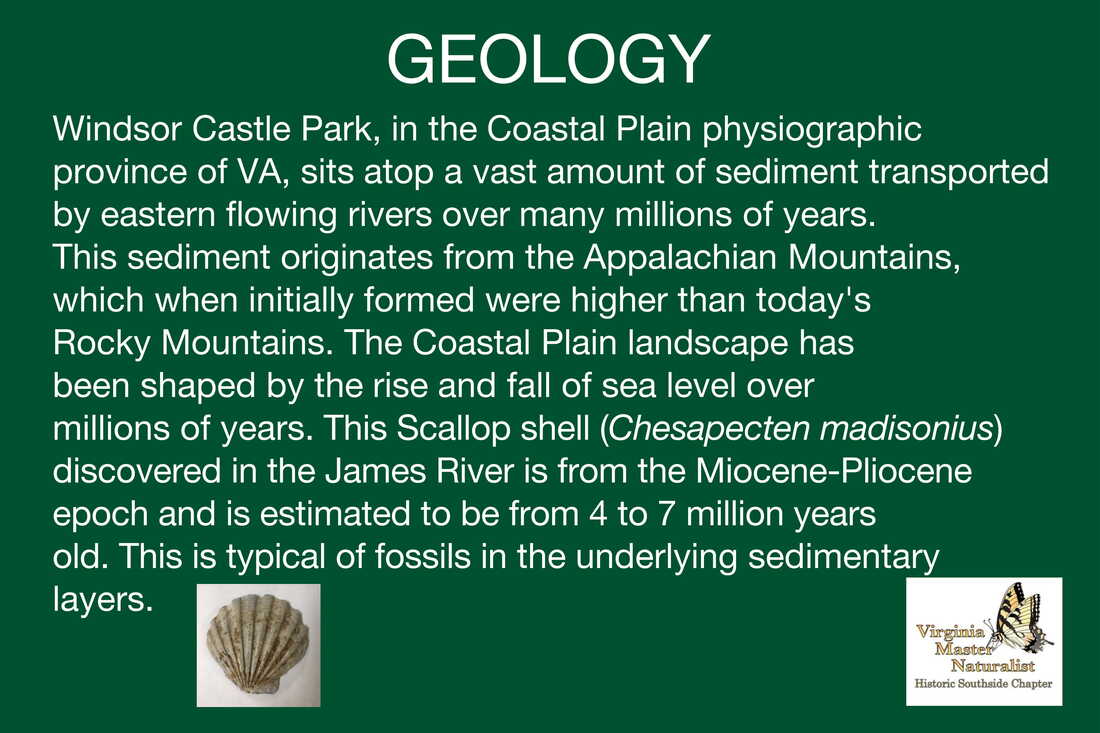Introduction
The oldest part of the park is found in the ancient sandy soil beneath your feet. The terraced landscape, or stair-step formations, found in this part of Virginia formed as sea-level rose and fell in response to changes in continental glaciers and uplift. The Shirley formation, named for the Shirley Plantation, is found in the area of Cypress Creek and north of the Pagan River. Each land area is geologically named based on its soil and rock strata. In this case, riverbank and sand deposits combined to create the loamy soil, a soil with roughly equal proportions of sand, silt, and clay. Found below the Shirley Formation is the older Yorktown Formation which contains fine marine sand and fossils. One of those marine fossils is the Chesapecten, a large species of scallop found in the shallow seas along the Mid-Atlantic. Though other scallops lived during these times, the Chesapectens were the most abundant. The jeffersonius lived during Early Pliocene time, found in the Yorktown Formation. The madisonius lived during Late Pliocene time, found in the Shirley Formation. The Chesapecten Jeffersonius became the official fossil of the Commonwealth of Virginia in 1993.
Some facts to consider
The oldest part of the park is found in the ancient sandy soil beneath your feet. The terraced landscape, or stair-step formations, found in this part of Virginia formed as sea-level rose and fell in response to changes in continental glaciers and uplift. The Shirley formation, named for the Shirley Plantation, is found in the area of Cypress Creek and north of the Pagan River. Each land area is geologically named based on its soil and rock strata. In this case, riverbank and sand deposits combined to create the loamy soil, a soil with roughly equal proportions of sand, silt, and clay. Found below the Shirley Formation is the older Yorktown Formation which contains fine marine sand and fossils. One of those marine fossils is the Chesapecten, a large species of scallop found in the shallow seas along the Mid-Atlantic. Though other scallops lived during these times, the Chesapectens were the most abundant. The jeffersonius lived during Early Pliocene time, found in the Yorktown Formation. The madisonius lived during Late Pliocene time, found in the Shirley Formation. The Chesapecten Jeffersonius became the official fossil of the Commonwealth of Virginia in 1993.
Some facts to consider
- Geologists have recorded five transgressive-regressive cycles to the Coastal Plain marine environment during the Pliocene (5.3-2.6 million years ago) and late Pleistocene (2.5 million years ago to 11,700 years ago).
- Though all the subsoil sediments found in the park are loamy, there are five different versions of loamy subsoil. Rumford (sandy loam) and Uchee (sandy clay loam) cover most of the park area between the creeks.
- The Chesapecten Jeffersonius was in such abundance during its time that it is used as an index fossil by geologists because it is easily identified by the 9 -12 ribs of the shell spreading out 7-11 inches and the rounded edge of the shell.








